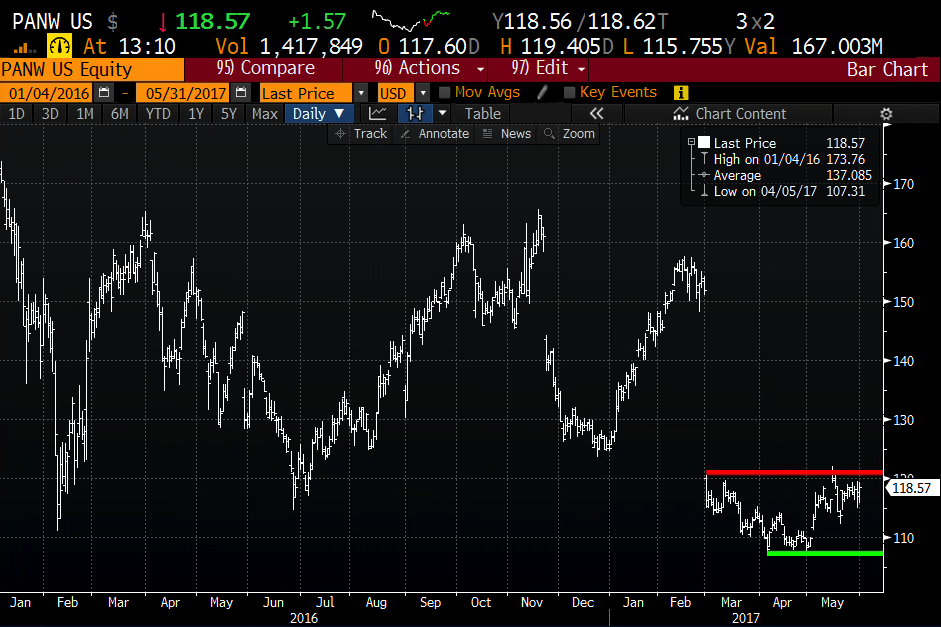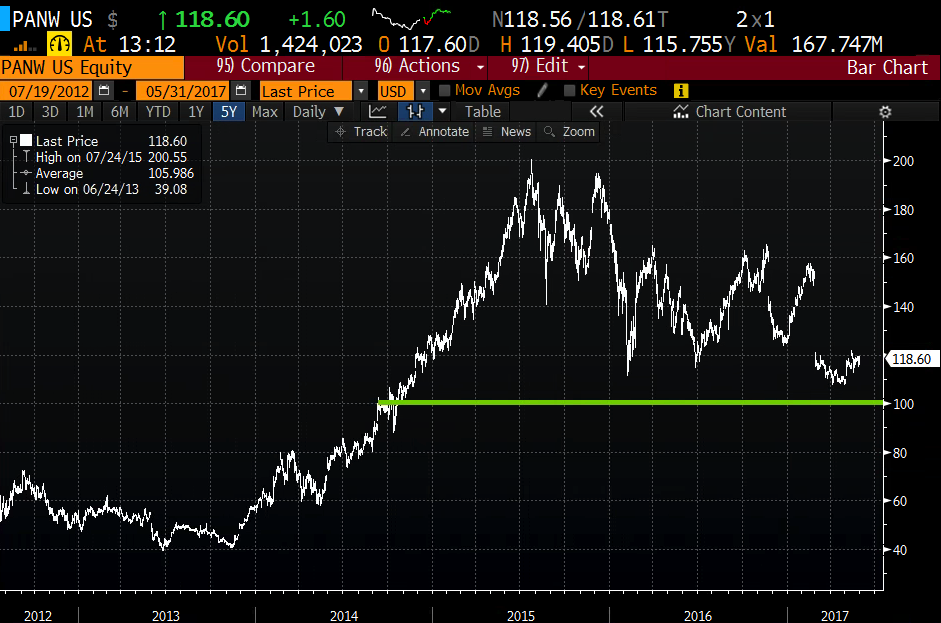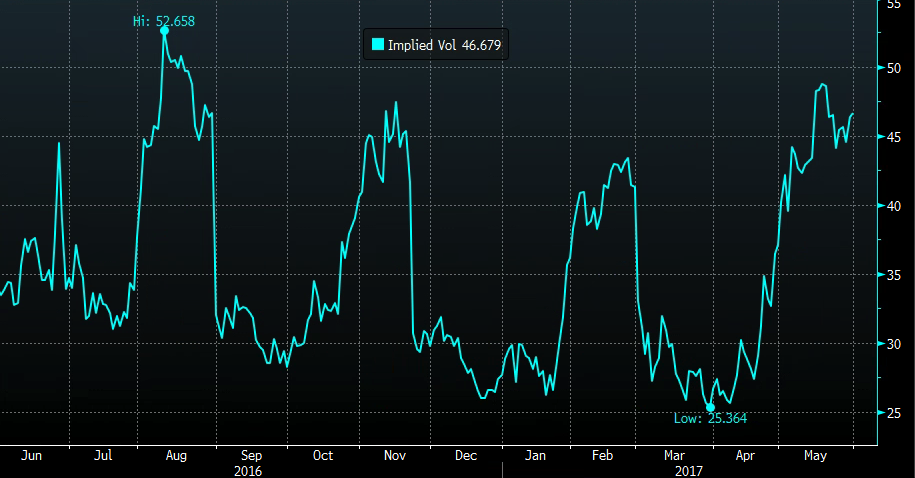Palo Alto Networks (PANW) is scheduled to report fiscal Q3 results tonight after the close. The options market is implying about a 10% one day move tomorrow, which is shy of the 14% average one day move following their last four quarterly reports, all of which have been lower (-24%, -13%, -7% and -12% respectively from Q2’17).
The 24% drop following their Q2 report was summed up fairly succinctly by my Options Action pal Michael Khouw back in early March in a guest post:
Despite year on year growth of 26%, company guidance and comments regarding operational challenges related to their go-to-market strategy clearly disappointed the street. Among other things management suggested that the introduction of new products in February may also have delayed customer purchases, however when pressed on whether sales should be expected to rebound now that the new products have been released, management indicated that the operational challenges, mostly due to the way they segment and allocate accounts to the sales team(s) might not be resolved until the second half. Management attempted to allay other concerns regarding increased competition from the likes of Cisco and Checkpoint (from whence the founder of PANW came), and migration to the cloud. One analyst asked whether the slowing could be an industry-wide phenomena after also seeing slowdowns at Checkpoint and Barracuda, management attempted to dismiss that as well.
Since early March shares of PANW have for the most part traded in a tight range between $107 and $121. Near term the stock has support down near the recent lows, and notable technical resistance at $120ish with a massive gap to fill back to $150:

A quick look at the 5-year chart though shows just how important it may be for PANW to hold the recent lows, which are also nearly 3-year lows, with little support to about $100:

The re-rating of the stock likely has something to do with it sales growth deceleration, from about 50% yoy on its way to a billion in sales in 2015, to the expected 21% in fiscal 2017 as it approaches $2 billion in sales. While their adjusted eps is expected to grow 33% in fiscal 2017, the loss on a GAAP basis is expected to be $2.30. Here again, I’ll quote Mike from his March post:
On a related note the company prefers to report adjusted non-GAAP results. On a GAAP basis the company’s $51m quarterly profit turns to a less attractive $61.8m loss. There is some value in evaluating the company’s performance excluding one-time charges such as the expenses related to moving into their new headquarters in this case, however persistent GAAP versus non-GAAP results aren’t really “one-time” charges are they if only the label for those exclusions change. If every quarter one could say “it’s always something with you”, making projections using GAAP earnings is likely a more sensible approach.
Of course for fast growing companies with good prospects investors may rightfully look to the future rather than the past, such as ongoing losses on a GAAP basis, however the slowing growth rate combined with the operational challenges might easily shake an investor’s faith.
So what now? A couple weeks ago Jefferies analyst John DiFucci upgraded his rating on the stock to a buy and slapped a $150 price target, up from $130, citing, per Barron’s Online:
PANW’s first major upgrade cycle was conducted in “big bang” fashion in February when we estimate that products that represent about 60% of its revenue were refreshed. We believe this was the primary driver of two weak quarters leading up to this, and it may result in at least one more, though very conservative April quarter guidance that implies the business deteriorates further may mitigate this risk at this time. In addition, the bar for the July quarter is not as onerous as investors think. We expect business momentum to improve within the next two quarters.
DiFucci keeps his estimates pretty much unchanged, though he goes through estimating its cash flow in years beyond 2018.
He sees higher free cash flow growth in 2020, on the order of 25% versus what he had thought would be just 20% growth. That “gives us more confidence in the re-acceleration of product sales at some point over the next couple quarters.”
Despite the massive gap lower following last quarter’s results, the stock is down only 5% on the year, which speaks to investors getting a tad offsides prior to the results. As DiFucci mentions in his upgrade note, the causes for the prior two weak reports could result in “at least one more” but the guide lower for the April quarter might have been low enough for the company to beat.
Short-dated options prices are nearly 9-month highs as investors are obviously a tad on edge prior to the print, defined risk short premium strategies might be the way to play the report:

Directionally, playing for one more miss and guide down feels like a press. However, if the company were to do so, the stock would likely outperform the implied move to the downside on its way to $100.
But given the stock’s poor sentiment, high short interest near 10% of the float, and the recent history of massive earnings gaps lower, playing for a gap fill near technical support looks like the more attractive play.
Risk Reversals could be the way to play, selling puts to buy calls, but the prudent way to do so would be to sell a put spread, define your downside risk, and use the premium sale to buy a call or call spread.
Here’s a trade we don’t talk about a bunch on the site but it could be of interest for some, as long as you understand the slightly more complicated risk reward. It’s a put spread/ call spread calendar risk reversal:
Bullish / Stock Alternative:
PANW ($119) Sell the June 2nd weekly 118/115 put spread, to Buy the July 125/150 call spread risk reversal for 2.70
It starts with selling a put spread near term:
Sell the June 2nd 118/115 put spread at 1.30
- Sell 1 June2nd 118 put at 4.90
- Buy 1 June2nd 115 put for 3.60
and then buying a call spread farther out in time.
Buy the July 125/150 call spread for $4
- Buy 1 July 125 call for 4.40
- Sell 1 July 150 call at .40
Breakeven On July Expiration – As long as the stock is above 118 on Friday, the July 125/150 call spread is at a cost of 2.70, with the chance to make up to 22.30 if the stock is at or above on 150 on July expiration. It’s break-even in that case is 120.70 with gains above and losses up to 2.70 below. However, the risk profile is different if the stock is below 118 into Friday.
Risk/Reward into Friday, June 2nd expiration – If the stock is below 118 on Friday there is added risk to the position as the put spread sold at 1.30 can lose up to 1.70. That is the maximum it can lose.
Total Risk/Reward – The most that can be lost on this trade is 5.70, the most that can be made is 22.30. The 5.70 is at risk if the stock is down sharply on earnings. The max gain is possible if the stock is higher, and if the stock is higher than 118 on Friday’s expiration, the risk is reduced to just 2.70 out until July.
Rationale – This trade takes advantage of high implied vol in the weeklies to finance a wide call spread in July. It is a slightly more complicated trade than what we normally detail, but it’s an interesting one with fairly favorable defined risk/reward.